Both Bridgestone Blizzak and the DM V2 are jagged tires built for optimized performance in winter period to cope with cold temperature, icy roads or snow-covered pathways.
Blizzak offers smooth drives over tracks covered with soft snow due to its higher evacuation capacity, it also provides firm steer handling over corners.
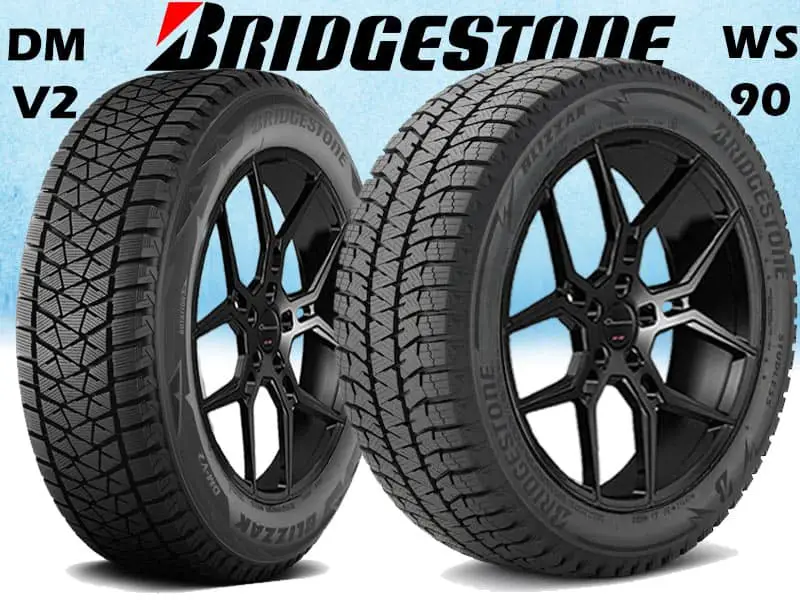
On the other side, DM V2 provides excellent grip on all kinds of roads whether dry, wet or icy owing to high contact patch and enhanced biting ability of its denser tread.
Lets compare both variants of Blizzak i.e. WS90 and 80 with DM V2.
Table of Contents
Blizzak WS90 vs DM V2
Bridgestone Blizzak DM V2
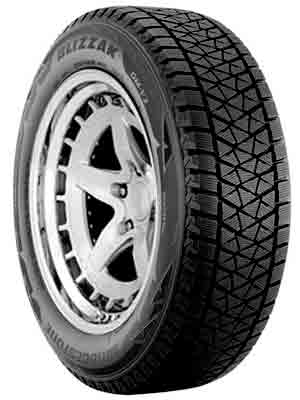
Bridgestone Blizzak Ws90
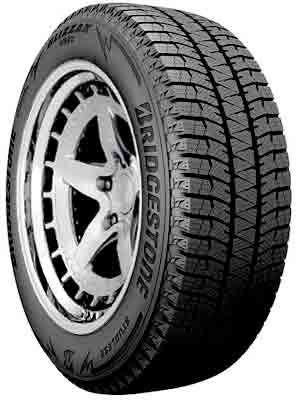
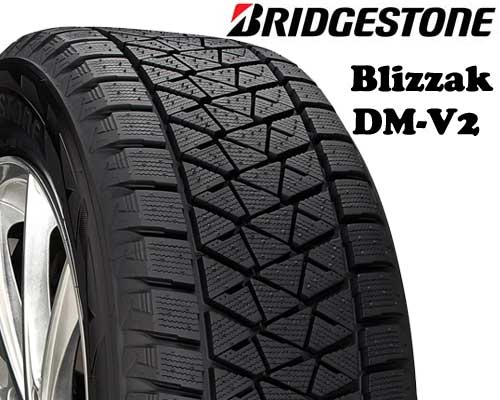
Vs

WS90 exhibits a symmetrical tread design with a unique endless, winding central rib having two massive grooves on its sides, zigzag sipes, notched edges and discontinuous groove passing through shoulders. Void ratio is relatively higher and minimizes contact patch which eventually cause reduction in grip of tread over dry roads. Open channels and sipes remove water and provide dependable aquaplaning resistance over wet tracks. Relatively increased void ratio proves beneficial when it comes to dealing with light snow over the road, snow is effectively evacuated through its broad grooves while moving ahead.
DM V2 characterizes a symmetrical and directional tread pattern with two main wide, longitudinal grooves along with zigzag spacing among central ribs forming two narrow grooves, 3D zigzag sipes, triangular blocks with saw-tooth edges over central ribs and square shaped shoulder lugs. Denser arrangement of lugs and low void ratio in central ribs makes contact patch of tread higher, increasing its ability to hold on the surface tightly, as a result dry grip is maximized. Slanting voids and 3D zigzag sipes provide good aquaplaning resistivity and account for excellent grip on wet and icy roads, less angular shoulder lugs without traction notches/edges make handling a bit difficult as compared with its competitor. Relatively low void ratio decreases snow traction in comparison as soft snow evacuation capacity of its grooves is lesser than WS90.
Road Grip Comparison
WS90 shows lesser grip on hard paved roads owing to its high void ratio. Broad grooves along the sides of central rib and dashed longitudinal grooves passing along shoulder lugs reduce contact patch of tread in comparison, as a result dry grip is minimized. Although lesser number of sipes on WS90 decrease traction over wet and icy roads as compared with its competitor yet its large grooves and zigzag sipes wipe away watery substances, providing reliable hydroplaning resistance. On the other hand, its high void ratio favors it while roaming about snow covered areas as its massive grooves can throw out snow and slush, cleaning tread and clearing its pathway as it rolls forward.
DM V2 has two major longitudinal grooves and spaces among blocks of central ribs, this arrangement leads to low void ratio and higher contact patch, resulting as superior grip of tread on dry tracks. Biting edges of its blocks further enhance its grip. Grip of DM V2 over wet roads and icy surfaces is better than its competitor as it has greater number of 3D zigzag sipes for wiping away slippery liquids efficiently. Thus, it shows lesser braking distances on all three; dry, wet and icy roads. However, this tire performs lesser in comparison when rolling over surfaces covered with soft snow. It has decreased efficiency to evacuate snow in backward direction due to lower void ratio.
Handling Comparison of the tires
WS 90 performs superior in terms of dry handling as its shoulder lugs are relatively larger, have more biting edges and maintain firm traction as the vehicle steers along the corners. Wide circumferential sipes along with thin horizontal sipes and a discontinuous groove provide enough space for removal of water and account for stable traction while cornering over wet and icy roads.
When it comes to handling the vehicle over tricky turns on dry roads, DM V2 loses the competition as its blocks have lesser contact patch and decreased biting ability. Small, squared shoulder lugs cannot maintain traction strongly while steering along corners over dry roads. The same story goes over wet and icy roads but frequent siping improves traction on wet/icy roads, to some extent.
Comparison of Hydroplaning Resistance
Both tires show excellence in terms of hydroplaning resistance due to their distinguished tread designs, however, DM V2 seems winning owing to higher number of sipes and angular grooves among blocks of central portion. Numerous 3D zigzag sipes and slanting voids efficiently wipe off slippery liquids from the surface and allow the tread to grip firmly on paved area as a result of better aquaplaning resistance.
WS90 has reliable aquaplaning resistivity but its ability to wipe away disturbing fluids is slightly lesser in comparison as number of sipes is lesser and its lateral grooves are relatively straight and less angular. However, massive grooves, zigzag sipes and crisscross design of central rib account for wiping away watery substances and resist hydroplaning satisfactorily but the competitor takes the lead in this respect.
Comparison of Rolling Resistance
WS90 is fuel efficient in comparison as it needs less energy to roll over the roads. High void ratio reduces surface area of tread that touches the ground directly, minimizing hysteresis produced and leading to lesser rolling resistance.
As DM V2 has low void ratio, its contact patch is markedly higher and the tread faces more rolling resistance as relatively large surface area require more energy for rolling over. The more surface area of tread is in contact with road, the more hysteresis (i.e. energy loss) is produced and more fuel is burnt to overcome high rolling resistance.
Comfort and Noise Comparison
WS90 is a louder tire comparatively due to its broad grooves. Its open voids offer more space for movement, reflection and resonation of wind particles leading to much noise while rolling along. Lesser traction due to lesser contact patch may make the rides little bit wobbly and less comfortable in comparison.
DM V2 produces lesser noise and offers more comfort than its competitor due to low void ratio of its tread. Narrow width and slanting arrangement of grooves not only allow limited space for wind collisions but also cancel out the effects of resonation of sound waves, leading to quieter rides. High contact patch with deep biting tread elements provide stable traction and comfortable driving experience on road.
Durability and tread wear
Like most winter tires, both of these tires do not come with any mileage warranty for tread wear. Moreover, as both of these tires come from Blizzak series from same manufacturer they employ similar tread composition characterizing dual compound structure with first 55% being NanoPro Tech multicell material with hydrophilic properties and enhanced traction capacity over snow while the remaining 45% features Bridgestone’s standard compound. After 55% wear a built in depth indicator points out that tread is reaching near its end.
Based on tread design we can say that DM V2 would wear out faster as more of its tread is in direct contact with surface and it faces more rolling resistance. On the other side high void ratio reduces rolling resistance and makes WS90 wear slower and last longer.
Comparing Blizzak WS80 with DM V2
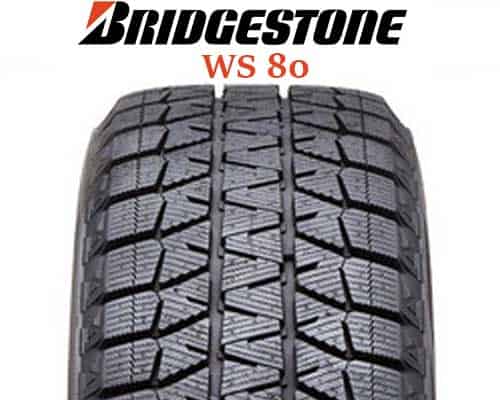
Vs

The Tread of WS80 has a symmetrical design with two broad grooves along the sides of its central rib while two discontinuous grooves are formed due to notching of shoulder lugs. It has frequented multidirectional zigzag sipes embedded in its tread as well. Its relatively high void ratio reduces the contact patch of tread which in turn minimizes its grip on a dry road. Frequent, full depth, multidirectional, zigzag sipes, and open channels wipe the water away and provide enough hydroplaning resistance over wet tracks. A high void ratio provides an advantage when it comes to dealing with light snow over the road as its broad grooves effectively evacuate snow through tread while moving ahead. On the ice, it lacks due to a lower contact patch.
DM V2 exhibits a symmetrical tread with two wide longitudinal grooves and less wide spacing among central ribs, zigzag sipes, square-shaped shoulder lugs, and triangular blocks of central rib, some of which have saw-toothed edges. Low void ratio and denser placement of blocks in central ribs result in a higher contact patch of tread which increases its ability to hold on the road strongly and maximize grip on dry paved surface. 3D zigzag sipes and slanting voids provide good resistivity against hydroplaning and result in excellent grip on a wet track. Small, squared shoulder lugs without traction notches present some difficulty in steer handling as compared to its competitor. Snow traction is lesser in comparison due to the relatively low void ratio as its grooves have comparatively less capacity to evacuate soft snow through them. On the ice, it excels due to its larger contact area.
Road Grip Comparison
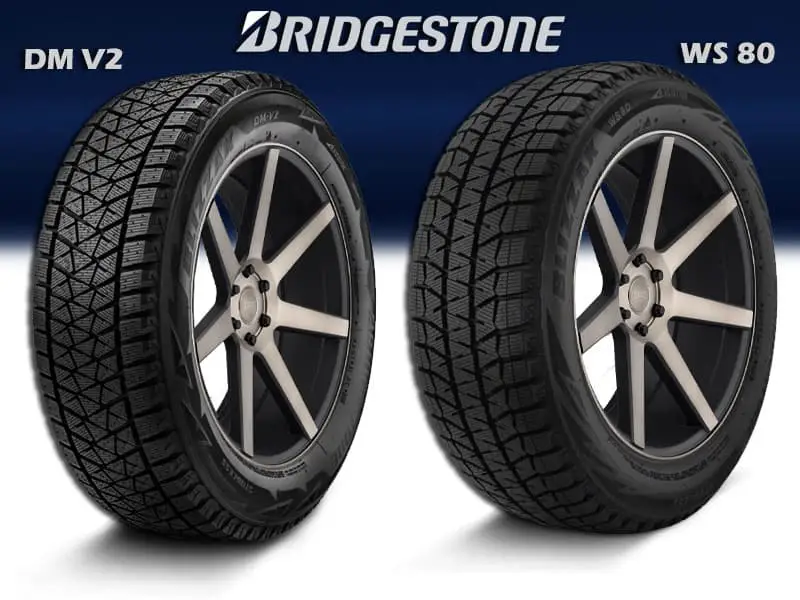
On hard paved roads, WS80 shows lesser grip owing to its relatively high void ratio. Broad channels along the sides of the central rib and disjointed longitudinal grooves passing along shoulder blocks decrease the surface area of tread in contact with the road, resulting in relatively reduced dry grip. Its large grooves and zigzag sipes wipe away water and provide reliable hydroplaning resistance and good wet traction. In snow-packed areas, it can roll smoothly because its grooves proficiently bite over soft snow and throw it in a backward direction while moving forward. Its grip on ice is reduced to the lower contact patch of its tread.
DM V2 has a relatively low void ratio and high contact patch because it possesses two major longitudinal grooves and spaced arrangement of blocks over the central ribs, resulting in the superior grip of tread on paved surface. It grips over the wet road more firmly as zigzag sipes and relatively deeper channels among triangular blocks efficiently wipe off water from the surface. On the other side, this tire performs somewhat lesser in comparison, on snow-covered surfaces because it has less efficiency to evacuate snow in a backward direction due to its low void ratio. Its grip on ice is better, owing to its higher contact patch.
Handling Comparison
The aggressive design of shoulders makes WS80 superior in terms of dry handling as it has relatively large shoulder lugs, providing a higher contact patch, thus, they ensure stable traction while turning over the corner. On a wet road, disjointed grooves, wide longitudinal sipes and zigzag horizontal sipes marked on shoulders wipe off water and offer firm handling overturns. While taking turns over a snowy surface, its lateral grooves offer comparatively lesser traction due to their lower depth. On the ice, the tire is considered better in terms of handling as it has a higher contact patch of its shoulders.
DM V2 stands behind in the competition when it comes to managing the steer over dry pavement because it has small square-shaped shoulder lugs which also lack traction notches over their edges. On a wet road, its sipes and deep voids remove water and provide satisfactory resistance against aquaplaning, leading to reliable handling experience upon turning about. It shows superior steer handling while moving along the corner on a snow-covered path because its lateral grooves are deeper and have a better ability to bite on and evacuate off soft snow. It lacks handling on ice due to the absence of a decent shoulder contact patch.
Comparison of Hydroplaning Resistance
Both tires have unique features to resist aquaplaning and come at par in this respect. WS80 shows optimum ability to resist aquaplaning, owing to its relatively high void ratio and frequent, wider sipes. Zigzag, multidirectional, full-depth sipes along with linear, lateral, and disjointed grooves perform a good job in wiping away water from the surface to minimize the risk of slipping off, however, lesser void depth tends to reduce its efficiency in comparison.
DM V2 is a little bit more efficient in resisting hydroplaning as its circumferential voids and lateral spaces among blocks are relatively deeper which along with help of zigzag sipes remove water away from the wet road.
Comparison of Rolling Resistance
The high void ratio of WS80 reduces the surface area in contact with the road, as a result, its tread faces less friction to roll over. Its fuel average is better in comparison as less energy is required to overcome lower rolling resistance.
On the other side, DM V2 has a higher contact patch because it has only two main longitudinal grooves and some spacing among blocks of central ribs. Owing to this denser arrangement its tread faces much resistance while rolling along and relatively large amounts of fuel is used to overcome this friction.
Comfort and Noise Comparison
WS80 produces a loud noise when it rolls over the road due to its high void ratio. Its channels provide no resistance to circulation of sound due to their rectilinear design, moreover, their relatively increased number makes free resonation of wind, possible.
DM V2 makes less noise while moving over the pavement as its fewer grooves offer less space for movement and collision of air particles, moreover, the zigzag pattern of central voids causes mutual cancellation of sound waves, as a result, minimal noise is produced.
Durability and Treadwear
Both tires come from the same Blizzak Winter tire series from Bridgestone tires, hence, these have similar tread composition. Their tread employs a hydrophilic coating for supreme ice and snow traction while 45% is Bridgestone standard winter tire compound. When half of the tread is worn, a built-in indicator signals about its consumption.
Pattern analysis of tread shows that WS80 is more durable in comparison. Its contact patch is minimized due to the high void ratio, consequently, its tread faces low rolling resistance and is slowly consumed against friction.
DM V2 has a comparatively higher contact patch and faces more rolling resistance due to which it wears down quickly as compared with its competitor.
Price
WS80 is costlier, however, it comes with the financial benefit of longer tread life and improved fuel average in comparison. On the other hand, you can make your mark over the icy pathway using DM V2 without taking out much from your budget.


